by Aljean Harmetz for The New York Times, August 3, 1986

On Stage 1 at the old Samuel Goldwyn studio on a hot day in the middle of last month, Lucille Ball came back. Barking the familiar laugh that blends a strangling Airedale with a porpoise, mugging for assistant directors and stagehands who weren’t even born when “I Love Lucy” went on the air in 1951, Lucille Ball came back to weekly television – 12 years after she left it.

Whether she was named Lucy Ricardo or Lucy Carmichael or Lucy Carter, whether she was the daffy housewife pinned to her kitchen wall by a loaf of homemade bread or the wacky widow wheedling a different sort of dough from a sour-faced banker, Lucille Ball was the queen of slapstick television comedy from 1951 to 1974. Now, a few weeks away from her 75th birthday, she is waiting to slide across a hardware store on a wheeled ladder in the first episode of a new series, “Life With Lucy.” It will be shown Saturday nights at 8 on ABC, starting in late September.

This time, she is Lucy Barker, a widow and a grandmother. In the initial episode, she moves into the Pasadena home of her daughter and son-in-law and her two grandchildren and takes over half-ownership of a hardware store run by the fuddy-duddy father of her son-in-law. He is, of course, played by Gale Gordon, her employer and comedic nemesis on “The Lucy Show” and “Here’s Lucy.” During the past few years, Mr. Gordon, who is 80, has been traipsing around the country performing in musical comedies.

Industry observers have serious doubts that “Life With Lucy” will succeed. In a recent printed forecast, Joel Segal, vice president and a buyer of commercials on prime-time television programs for the Ted Bates Advertising Agency, said that Miss Ball is “a broad physical comedienne who may have some difficulty doing boffo comedy in the midst of her eighth decade.”

“Everyone predicted ‘I Love Lucy’ would be a flop,” says Bob Carroll, unconcernedly. Mr. Carroll and his partner, Madelyn Davis, have been writing for Lucille Ball for 38 years, since her radio show, “My Favorite Husband,” in 1948. More recently, the team spent eight years as executive producers of the CBS situation comedy “Alice.”

Just today, Mr. Carroll and Miss Davis have discovered there is a pit under Stage 1. “So, we can have something where Lucy goes through a tarp into the basement,” says Miss Davis with delight.

When “Life With Lucy” was being planned this past spring, Miss Davis did offer one concession to Miss Ball’s age. “I said, ‘We won’t fly you,’ ’’ says Miss Davis, referring to putting a wire on an actor so he can do stunts. Miss Ball’s answer: ’’Oh, I can fly!’’

At first glance, at least, Miss Ball seems to be remarkably agile and limber. ’’I’m not dropping out of an airplane or jumping up and down on a trampoline this first show,” she says. ’‘But the Lucy character is the same as ever. To her, nothing is impossible. She’s going for it. This show is Lucy at another time in her life.“ And, indeed, as in all her earlier series, Miss Ball will be the centerpiece of every episode.

Wearing an over-sized yellow shirt over white slacks, with a gold print scarf tied loosely at her throat, Miss Ball is eating lunch in a huge dressing-room suite that her husband, Gary Morton, has already spent a week making homey. Although, to television audiences, she is indelibly married to Desi Arnaz – it was a national event when their son, Ricky Ricardo, was born on ’’I Love Lucy” in 1953 – she was divorced from Mr. Arnaz some 28 years ago and has been married to Mr. Morton, a comedian and producer, for nearly 25 years.

The walls are full of pictures Mr. Morton has hung, including a poster for Miss Ball’s 1974 movie – her last movie – “Mame.” Oddly, it was at this studio that her film career began in 1933. She was a “Goldwyn Girl,” a long-legged showgirl, in “Roman Scandals,” starring Eddie Cantor.
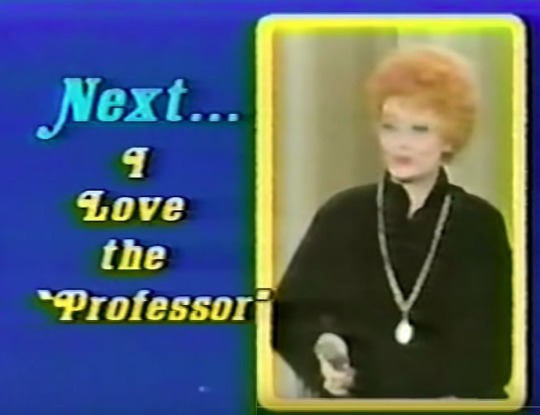
There is no single reason why she has returned to the grind of weekly television. “We went to Florida last year and did seminars, and people kept saying, ‘Please come back, please come back,’ and we started thinking about it,” says Mr. Morton. “She was bored,” says Madelyn Davis. “Lucy doesn’t want to sit at home in a rocking chair, going through her scrapbooks.”

Certainly, money was not the lure. Miss Ball and Mr. Arnaz were the first television stars to put their series on enduring film instead of impermanent kinescope, and some old “Lucy” show is being run on some television channel somewhere on any given day. Since CBS refused to allow Miss Ball and Mr. Arnaz to film in front of a audience, they decided in 1951 to borrow $5,000 and create their own space in which to film their pilot live. “That’s how we came to own the show,” Miss Ball says 35 years later, and there is still a tinge of wonder in her voice.

She paints her lips into a huge cupid’s bow and tosses the familiar red hair. “I’ve missed doing a television series,” she says. ’‘I didn’t realize it until two or three years ago, after I had paid back all the guest appearances to Carol Burnett and Bob Hope and the others, all the promises I had made, all the charity I had to catch up on.“
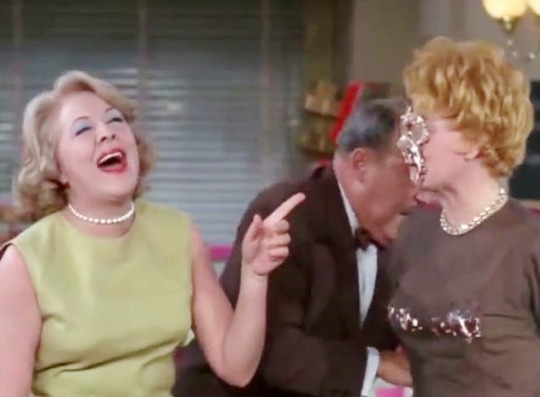
But there was a psychological barrier to overcome. ’’I missed Viv so much. And I couldn’t bear the thought of going on without her,” Miss Ball says. Vivian Vance, who died in 1979, had been Miss Ball’s friend and partner-in-mischief on all the “Lucy” series. On “Life With Lucy,” Lucy Barker will be provided with no woman friend or confidante. Miss Ball pushes the idea away with her hands. “No way, no way,” she says. “That’s one thing I draw the line on.” She says she decided to go for a new series because, with “The Bill Cosby Show,” “the cycle for this sort of thing, family
shows, came around again. I wouldn’t have to do a pilot. And Gale was available and so were my writers. Gale is the strength, the one I upset so he can hardly stand it and he recoils comedically. Hopefully, we’ll find plenty for him to bluster about.” (1)
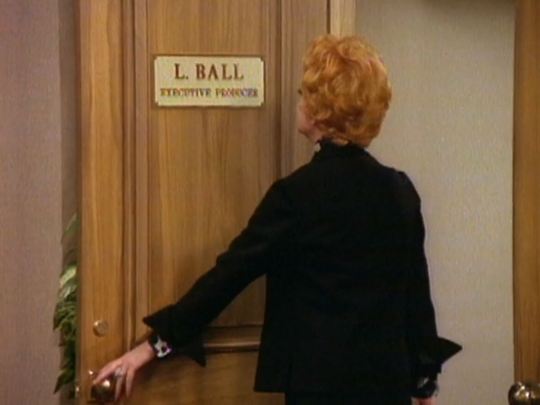
As always, Lucille Ball has creative control. “Young network executives are not going to walk in and tell Lucy what’s funny,” says Mr. Morton. The series is a co-venture of Lucille Ball Productions and Aaron Spelling Productions. It was Mr. Spelling who got Miss Ball excited -“like a war horse,” he says – about doing another series. And it was Mr. Spelling who made ABC commit to a firm order for 22 episodes, an unusually high number nowadays (2). “I’m sick of this prejudgment by age,” he says. “Does Bob Hope work? Does George Burns work?”

Across the television dial from “Life With Lucy,” at 9 P.M., on NBC’s “Golden Girls,” the dialogue is crammed with sexual jokes and middle-aged widows bring men home to bed. Although Miss Davis speaks of “Life With Lucy” as “vintage Lucy turned into a today’s woman,’’ the show will have no sexual humor. ’’She’s never cared for that,’’ says Miss Davis. Instead, according to Miss Ball, ’’one premise will be my first date since my husband died, with a mother-daughter switch, the daughter worrying when her mother doesn’t get home on time.”

By “bringing the Lucy character up to date,’’ Miss Ball and Miss Davis mean that ’’Life With Lucy” will provide a stronger, less-dependent Lucy. “She was always kind of childlike,” says Miss Davis, “afraid of her husband’s disapproval, saying, ‘Ricky will kill me!’ We wouldn’t do that today. She’s into jogging and health foods, a grandmother and not a scatterbrained wife. She’s gotten a little smarter through the years, and a little more worldly. In several scripts she says things like, ‘Why am I clinging to the past?’ And she tries to see things through her grandchildren’s
eyes.”
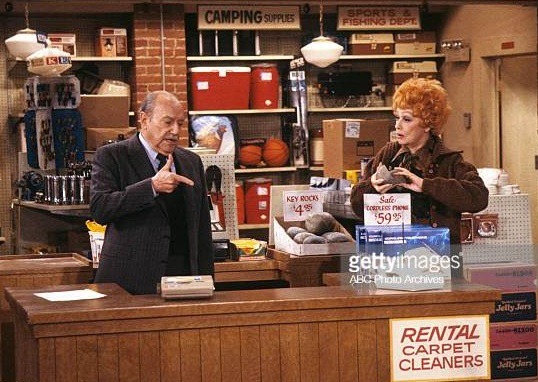
“Lucy is not as dependent on anyone, except under the blowtorch of Gale,” says Miss Ball. ’‘I go into the hardware store and re-arrange everything alphabetically and give them apoplexy.“
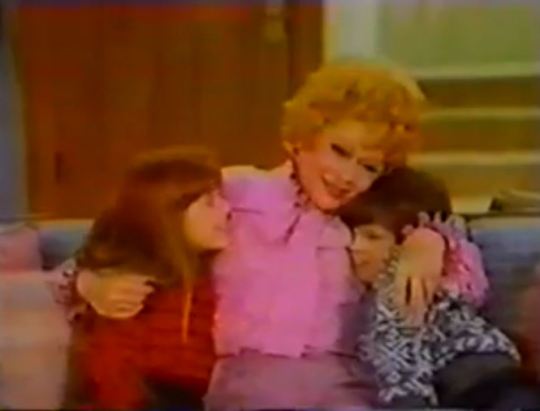
She is standing inside the hardware-store set on Stage 1, waiting to rehearse among the rakes and hoses and bins of plastic tubing. The two young children who play her grandchildren pass the time by playing with flashlights on an open shelf. When the rehearsal begins, they come too tentatively into the shop. Told to walk faster, they are still too slow. Patiently, Miss Ball takes them by the hand and demonstrates. She bursts into the shop, shouting ’’Grandpa!”

The hardware store was her idea. “It gives us a lot of gadgets to work with,” she says, grinning.
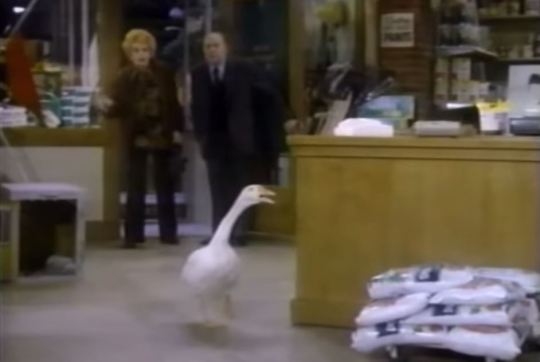
In the first show, she fights with a defective fire extinguisher. The following week, the problems will be with a guard goose. (3) “She doesn’t mind working with animals,” says Miss Davis. ’‘We’ve had her with three sheep, a chimp and an elephant, and milking a cow.’‘ (4) Eventually, she will convince Mr. Gordon to put his inventory on a computer and will manage to erase it. And there is always that sliding ladder.
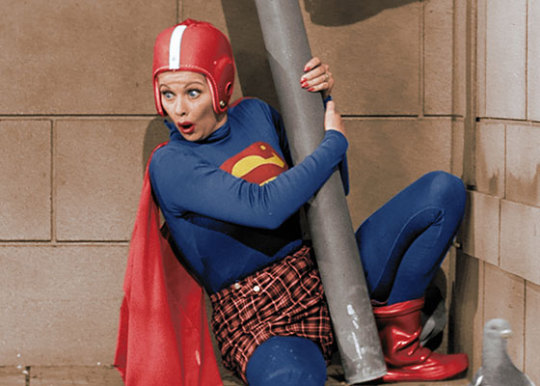
There is also sleight of mind. “We didn’t have as much physical comedy as you think,” says Mr. Carroll of the old “Lucy” shows. “She wore funny outfits and was in funny situations – out on a ledge with pigeons on her head.’’ (5)
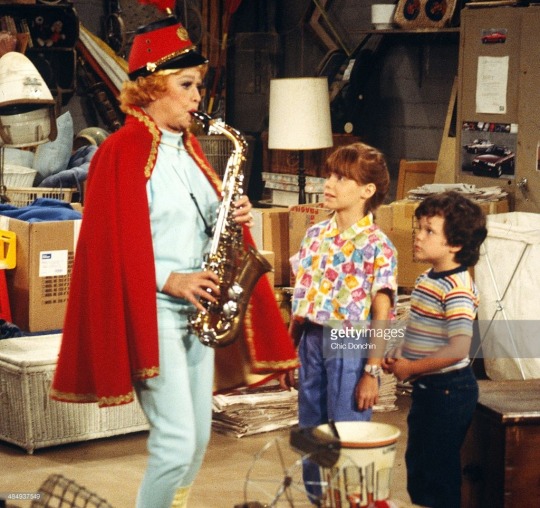
In equivalent ’’Life With Lucy” scenes, she will drink a health-food concoction and turn as rubbery as an octopus. Or, in classic “Lucy” style, she will get her hand stuck in a saxophone. The sax is sitting on a desk in her dressing room. She really plays, although badly. In her spare moments, she is trying to strengthen her lips so she can struggle through the whole “Marines’ Hymn” for a scene with a high-school band in a future show.

During one of the endless waits between scenes, Miss Ball’s chair becomes surrounded by crew members eager to listen. “What are you going to do now, Director Man?” she teases Peter Baldwin. A few moments later, Mr. Baldwin tells her to deliver a line from the third step of the stairs of the three-story gabled stage house. Instantly, Miss Ball decides that the line works more amusingly from the bottom step instead. “You don’t give a chance for a laugh, if you don’t wait,” she explains to the director who is 25 years her junior.

“I didn’t expect it to last,” Miss Ball said later of “I Love Lucy.” “Nobody wanted me to go into television. Everybody at Metro [M-G-M], where I was under contract, said I was out of my mind. And then, when Desi and I went on a tour and there were 5,000 people outside a steel fence at the Miami Airport and they trampled it, and people knocked down a plate-glass window at the lobby of one hotel – we didn’t know what was happening.” (6)
That was a long time ago. Today is a different country. Will re-cycled “Lucy” seem old-fashioned? (7)

While Miss Ball and her husband were wavering, a friend pushed them over the edge to “Life With Lucy.” “Why not?” the friend told them. ’‘You have nothing to lose.“ Whatever happens, says Mr. Morton, is ’’icing on the cake.”
FOOTNOTES aka HINDSIGHT IS 20/20
(1) Although Lucille did not want a female co-star, the final episode aired featured Audrey Meadows as Lucy’s sister. Critics remarked on their comic chemistry and theorized that had Meadows been a regular cast member the show might have stood a chance. Too little, too late.
(2) The series order was reduced to 13, with only 8 episodes airing. A 14th was being plan when the ax fell.
(3) “Lucy and the Guard Goose” was filmed second, but was replaced with “Lucy Makes a Hit With John Ritter” to boost ratings with a guest star. “Lucy and the Guard Goose” was moved to episode 9, but the show was cancelled after episode 8 on November 15, 1986, and “Guard Goose” went un-aired. Ironically, a clip of the episode featuring the goose was already part of the opening credit sequence, leaving viewers wondering “what’s with the goose?”
(4) Madelyn Martin is under-rating Lucy’s experience with animals. On “The Lucy Show” there was a pen full of sheep, not just three. On television alone, Ball has worked with seven chimps, three elephants, and milked two cows! This in addition to other animals of almost every description.
(5) Carroll is referring to “Lucy and Superman” (1956) where Lucy Ricardo impersonates the Man of Steel to surprise her son, making her entrance through a window populated by pigeons.
(6) Ball is remembering an experience in November 1956 when Lucy and Desi visited Miami in advance of their setting several episodes of “I Love Lucy”.
(7) Very quickly it became apparent that the answer was “no” – America and the critics did not embrace “Life With Lucy”, which was cancelled after eight episodes, much to the dismay of Ball, who was devastated by its failure.
[The article’s text has been reprinted verbatim. The images have been added to enhance the reading experience. Some images property of Getty Images Inc.]

Leave a comment